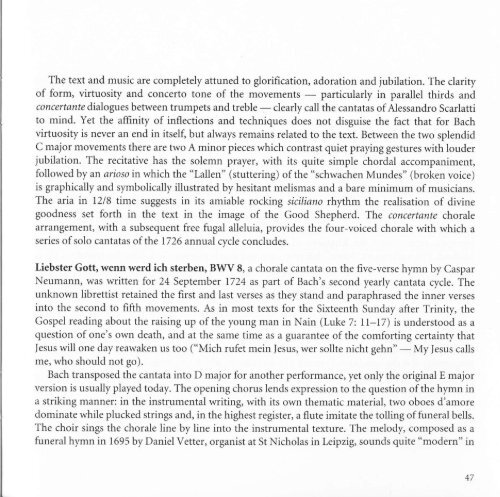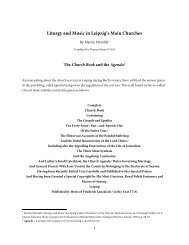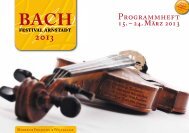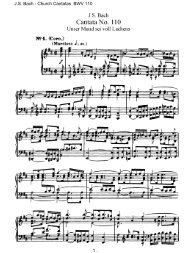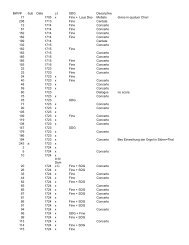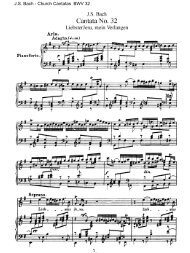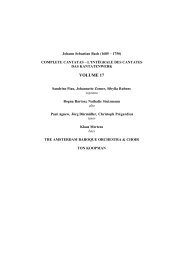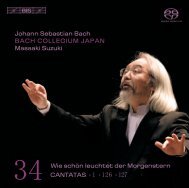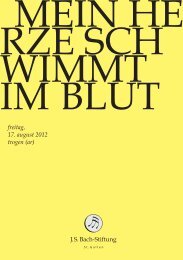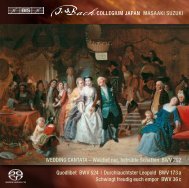Bach Cantatas, Vol. 2 - F. Werner (Erato 10-CD)
Bach Cantatas, Vol. 2 - F. Werner (Erato 10-CD)
Bach Cantatas, Vol. 2 - F. Werner (Erato 10-CD)
You also want an ePaper? Increase the reach of your titles
YUMPU automatically turns print PDFs into web optimized ePapers that Google loves.
The text and music are completely attuned to glorification, adoration and jubilation. The clarity<br />
of form, virtuosity and concerto tone of the movements<br />
-<br />
particularly in parallel thirds and<br />
concertante dialogues between trumpets and treble<br />
-<br />
clearly call the cantatas ofAlessandro Scarlatti<br />
to mind. Yet the affinity of inflections and techniques does not disguise the fact that for <strong>Bach</strong><br />
virtuosity is never an end in itsell but always remains related to the text. Between the two splendid<br />
C major movements there are two A minor pieces which contrast quiet praying gestures with louder<br />
jubilation. The recitative has the solemn prayer, with its quite simple chordal accompaniment,<br />
followed by an arioso in which the "Lallen" (stuttering) of the "schwachen Mundes" (broken voice)<br />
is graphically and syrnbolically illustrated by hesitant melismas and a bare minimum of musicians.<br />
The aria in l2l8 time suggests in its amiable rocking siciliano rhythm the realisation of divine<br />
goodness set forth in the text in the image of the Good Shepherd. The concertante chorale<br />
arrangement, with a subsequent free fugal alleluia, provides the four-voiced chorale with which a<br />
series of solo cantatas of the L726 annual cycle concludes.<br />
Liebster Gott, wenn werd ich sterben, BWV 8, a chorale cantata on the five-verse h1,rnn by Caspar<br />
Neumann, was written for 24 September 1724 as part of <strong>Bach</strong>'s second yearly cantata cycle. The<br />
unknown librettist retained the first and last verses as they stand and paraphrased the inner verses<br />
into the second to fifth movements. As in most texts for the Sixteenth Sunday after Trinity, the<br />
Gospel reading about the raising up of the young man in Nain (Luke 7: ll-17) is understood as a<br />
question of one's own death, and at the same time as a guarantee of the comforting certainty that<br />
Jesus will one day reawaken us too ("Mich rufet mein Jesus, wer sollte nicht gehn"<br />
-<br />
My Jesus calls<br />
me, who should not go).<br />
<strong>Bach</strong> transposed the cantata into D major for another performance, yet only the original E major<br />
version is usually played today. The opening chorus lends expression to the question of the hymn in<br />
a striking manner: in the instrumental writing, with its own thematic material, two oboes d'amore<br />
dominate while plucked strings and, in the highest register, a flute imitate the tolling of funeral bells.<br />
The choir sings the chorale line by line into the instrumental texture. The melody, composed as a<br />
funeral hymn in 1695 by Daniel Vetter, organist at St Nicholas inLerpzig, sounds quite "modern" in


